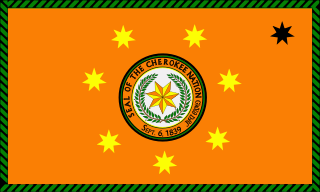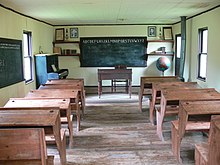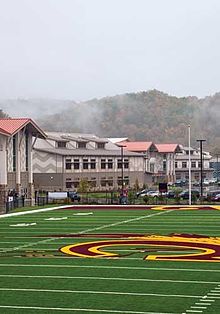
Cherokee or Tsalagi is an endangered-to-moribund Iroquoian language and the native language of the Cherokee people. Ethnologue states that there were 1,520 Cherokee speakers out of 376,000 Cherokee in 2018, while a tally by the three Cherokee tribes in 2019 recorded ~2,100 speakers. The number of speakers is in decline. The Tahlequah Daily Press reported in 2019 that most speakers are elderly, about eight fluent speakers die each month, and that only 5 people under the age of 50 are fluent. The dialect of Cherokee in Oklahoma is "definitely endangered", and the one in North Carolina is "severely endangered" according to UNESCO. The Lower dialect, formerly spoken on the South Carolina–Georgia border, has been extinct since about 1900. The dire situation regarding the future of the two remaining dialects prompted the Tri-Council of Cherokee tribes to declare a state of emergency in June 2019, with a call to enhance revitalization efforts.

Cherokee is a census-designated place (CDP) in Swain and Jackson counties in Western North Carolina, United States, within the Qualla Boundary land trust. Cherokee is located in the Oconaluftee River Valley around the intersection of U.S. Routes 19 and 441. As of the 2020 census, the CDP had a population of 2,195. It is the capital of the federally recognized Eastern Band of Cherokee Indians, one of three recognized Cherokee tribes and the only one in North Carolina.

The Qualla Boundary or The Qualla is territory held as a land trust by the United States government for the federally recognized Eastern Band of Cherokee Indians (EBCI), who reside in Western North Carolina. The area is part of the large historic Cherokee territory in the Southeast, which extended into eastern Tennessee, western South Carolina, northern Georgia and Alabama. Currently, the largest contiguous portion of the Qualla lies in Haywood, Swain, and Jackson counties and is centered on the community of Cherokee, which serves as the tribal capital of the Eastern Band of Cherokee Indians. Smaller, non-contiguous parcels also lie in Graham and Cherokee counties, near the communities of Snowbird and Murphy, respectively.
A medium of instruction is a language used in teaching. It may or may not be the official language of the country or territory. If the first language of students is different from the official language, it may be used as the medium of instruction for part or all of schooling. Bilingual education or multilingual education may involve the use of more than one language of instruction. UNESCO considers that "providing education in a child's mother tongue is indeed a critical issue". In post-secondary, university and special education settings, content may often be taught in a language that is not spoken in the students' homes. This is referred to as content based learning or content and language integrated learning (CLIL). In situations where the medium of instruction of academic disciplines is English when it is not the students' first language, the phenomenon is referred to as English-medium instruction (EMI).
The Eastern Band of Cherokee Indians (EBCI), is a federally recognized Indian tribe based in western North Carolina in the United States. They are descended from the small group of 800–1,000 Cherokee who remained in the Eastern United States after the U.S. military, under the Indian Removal Act, moved the other 15,000 Cherokee to west of the Mississippi River in the late 1830s, to Indian Territory. Those Cherokee remaining in the east were to give up tribal Cherokee citizenship and to assimilate. They became U.S. citizens.

The Cherokee Nation, also known as the Cherokee Nation of Oklahoma, is the largest of three Cherokee federally recognized tribes in the United States. It includes people descended from members of the Old Cherokee Nation who relocated, due to increasing pressure, from the Southeast to Indian Territory and Cherokee who were forced to relocate on the Trail of Tears. The tribe also includes descendants of Cherokee Freedmen, Absentee Shawnee, and Natchez Nation. As of 2023, over 450,000 people were enrolled in the Cherokee Nation.
Joyce Dugan is an American educator, school administrator, and politician; she served as the 24th Principal Chief of the federally recognized Eastern Band of Cherokee Indians (1995-1999), based in Western North Carolina. She was the first woman to be elected to this office, and as of 2024 the only one.

Nikwasi comes from the Cherokee word for "star", Noquisi (No-kwee-shee), and is the site of the Cherokee town which is first found in colonial records in the early 18th century, but is much older. The town covered about 100 acres (40 ha) on the floodplain of the Little Tennessee River. Franklin, North Carolina, was later developed by European Americans around this site.

Kituwa or giduwa (Cherokee:ᎩᏚᏩ) is an ancient Native American settlement near the upper Tuckasegee River, and is claimed by the Cherokee people as their original town. An earthwork platform mound, built about 1000 CE, marks a ceremonial site here. The historic Cherokee built a townhouse on top that was used for their communal gatherings and decisionmaking; they replaced it repeatedly over decades. They identify Kituwa as one of the "seven mother towns" in their traditional homeland of the American Southeast. This site is in modern Swain County, North Carolina, in the Great Smoky Mountains.

Native American politics remain divided over different issues such as assimilation, education, healthcare, and economic factors that affect reservations. As a multitude of nations living within the United States, the Native American peoples face conflicting opinions within their tribes, essentially those living on federally approved reservations. Interactions with the federal government and the overall American culture surrounding them influence day-to-day tribal life. Native American culture as a whole rests between the divide of the traditionalists and those who wish to trade the old ways for improved conditions.

Cherokee Preservation Foundation is an independent nonprofit foundation established in 2000 as part of the Tribal-State Compact amendment between the Eastern Band of Cherokee Indians (EBCI) and the State of North Carolina. The Foundation is funded by the EBCI from gaming revenues generated by the Tribe; it is not associated with any for-profit gaming entity and is a separately functioning organization independent of the Tribal government. It works to improve the quality of life of the EBCI and strengthen the western North Carolina region by balancing Cherokee ways with the pursuit of new opportunities.
Ravensford is an unincorporated community in Swain County, Western North Carolina. This is within the traditional homeland of the Cherokee people. In a survey and excavation project in the early 21st century, part of the community was found to have archeological resources that were thousands of years old, in addition to more recent historic materials related to the Cherokee people. In 1938, the US Government and state of North Carolina negotiated with the Eastern Band of Cherokee Indians to gain their agreement to transfer some of their land to enable construction of the Blue Ridge Parkway. In return, lands in Ravensford were transferred to their Qualla Boundary property.

Cherokee language is the indigenous American Iroquoian language native to the Cherokee people. In 2019, the Tri-Council of Cherokee tribes declared a state of emergency for the language due to the threat of it going extinct, calling for the enhancement of revitalization programs.
Patrick Henry Lambert is a Native American tribal leader who served as the 27th Principal Chief of the Eastern Band of Cherokee Indians from 2015 to 2017. He also served as the Executive Director of the Cherokee Tribal Gaming Commission for over twenty years. Lambert was impeached on January 18, 2017, and removed from office on May 25, 2017.

Richard G. Sneed is the 28th Principal Chief of the Eastern Band of Cherokee Indians. Sneed succeeded former Principal Chief Patrick Lambert following Lambert's impeachment, only the second such impeachment since the 19th century.
The New Kituwah Academy, also known as the Atse Kituwah Academy, is a private bilingual Cherokee- and English-language immersion school for Cherokee students in kindergarten through sixth grade, located in Cherokee, North Carolina, in the Yellow Hill community of the Qualla Boundary. It is owned by the Eastern Band of Cherokee Indians (EBCI), and operated by the Kituwah Preservation and Education Program (KPEP).
Myrtle Driver Johnson is a native speaker of the Cherokee language. As of July 2019 she was one of 211 remaining Cherokee speakers in the Eastern Band of Cherokee Indians (EBCI).

Referendum Question #2, the Eastern Band of Cherokee Indians Marijuana Legalization Measure, was a ballot measure in the US that was sent to voters on September 7, 2023, by the Eastern Band of Cherokee Indians Tribal Council. The proposal sought to legalize the recreational use of cannabis on tribal lands for those over the age of 21, and to require the EBCI Tribal Council to adopt legislation to regulate legal cannabis.

Ernestine SharonWalkingstick was a Cherokee nurse and community leader, who established the first clinic for the Native American population in the town of Robbinsville, North Carolina, and was instrumental in founding the region's first domestic violence shelter.












